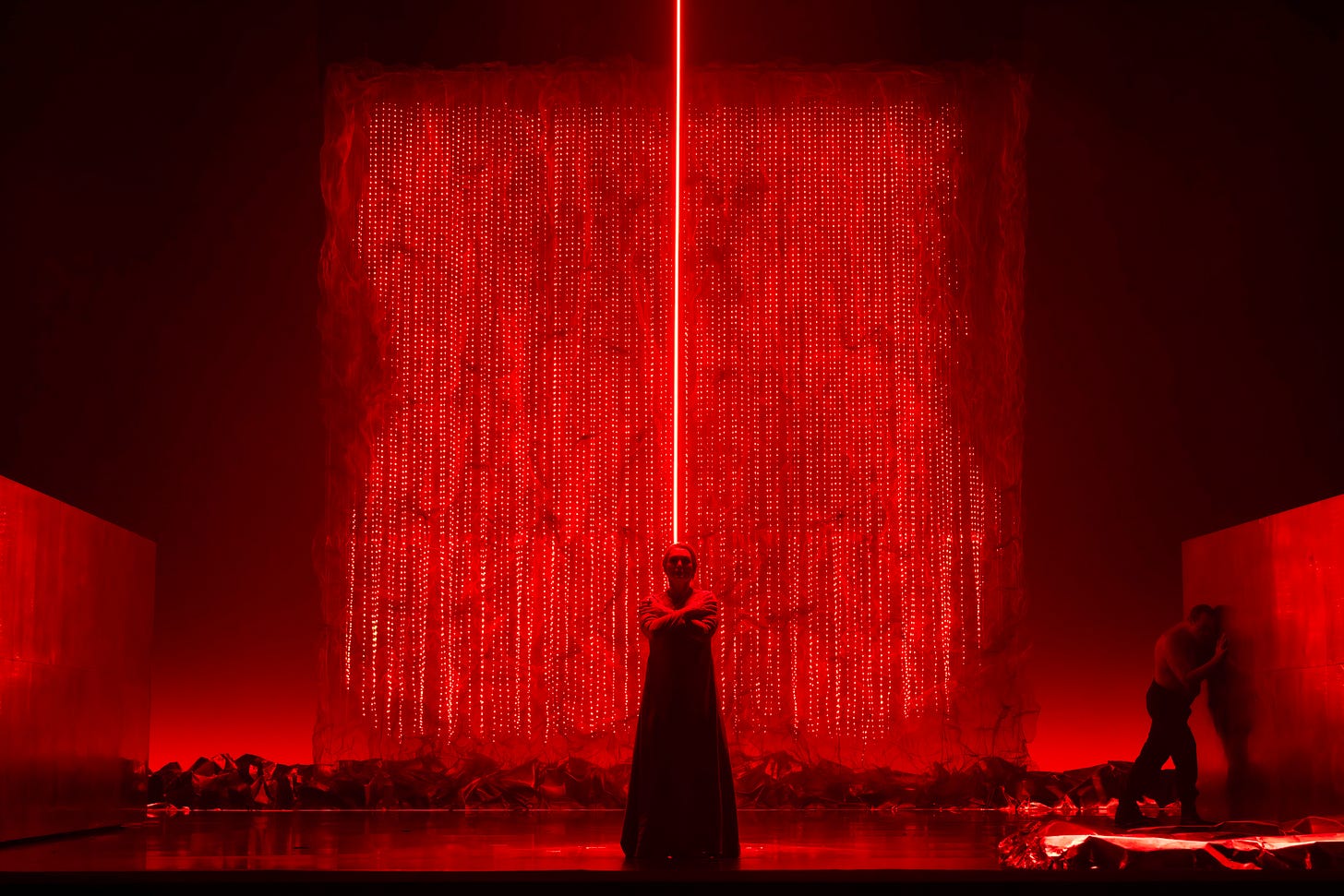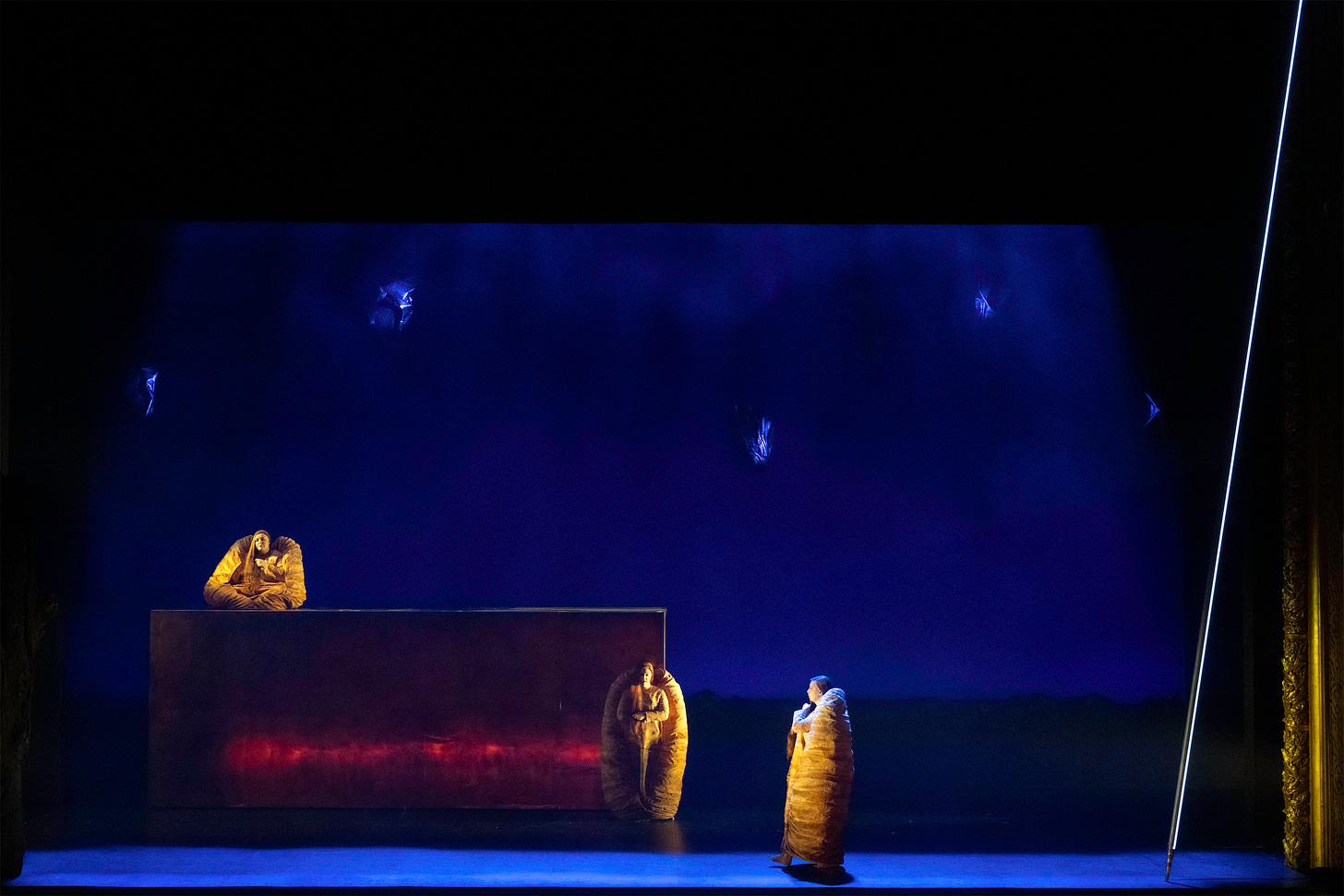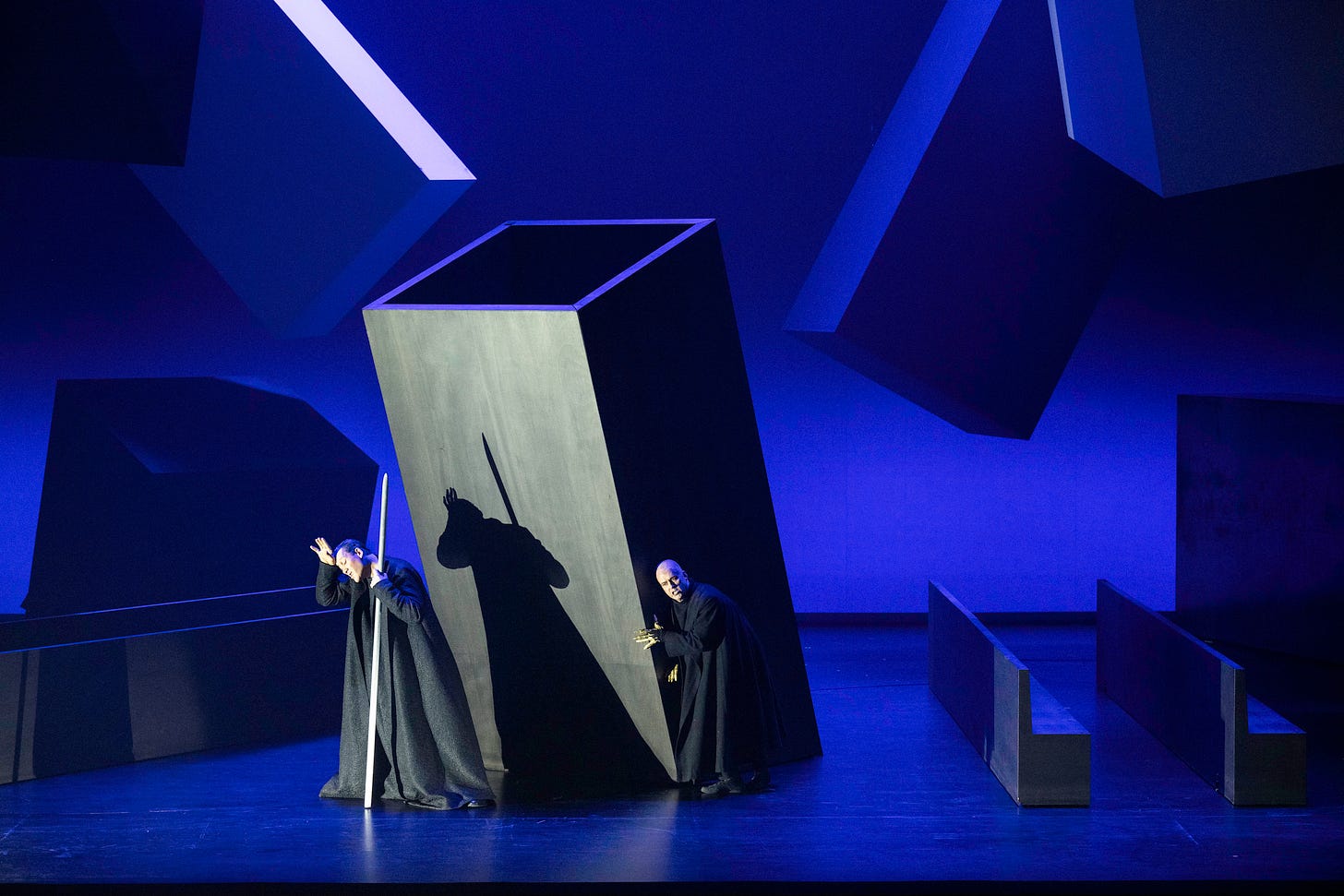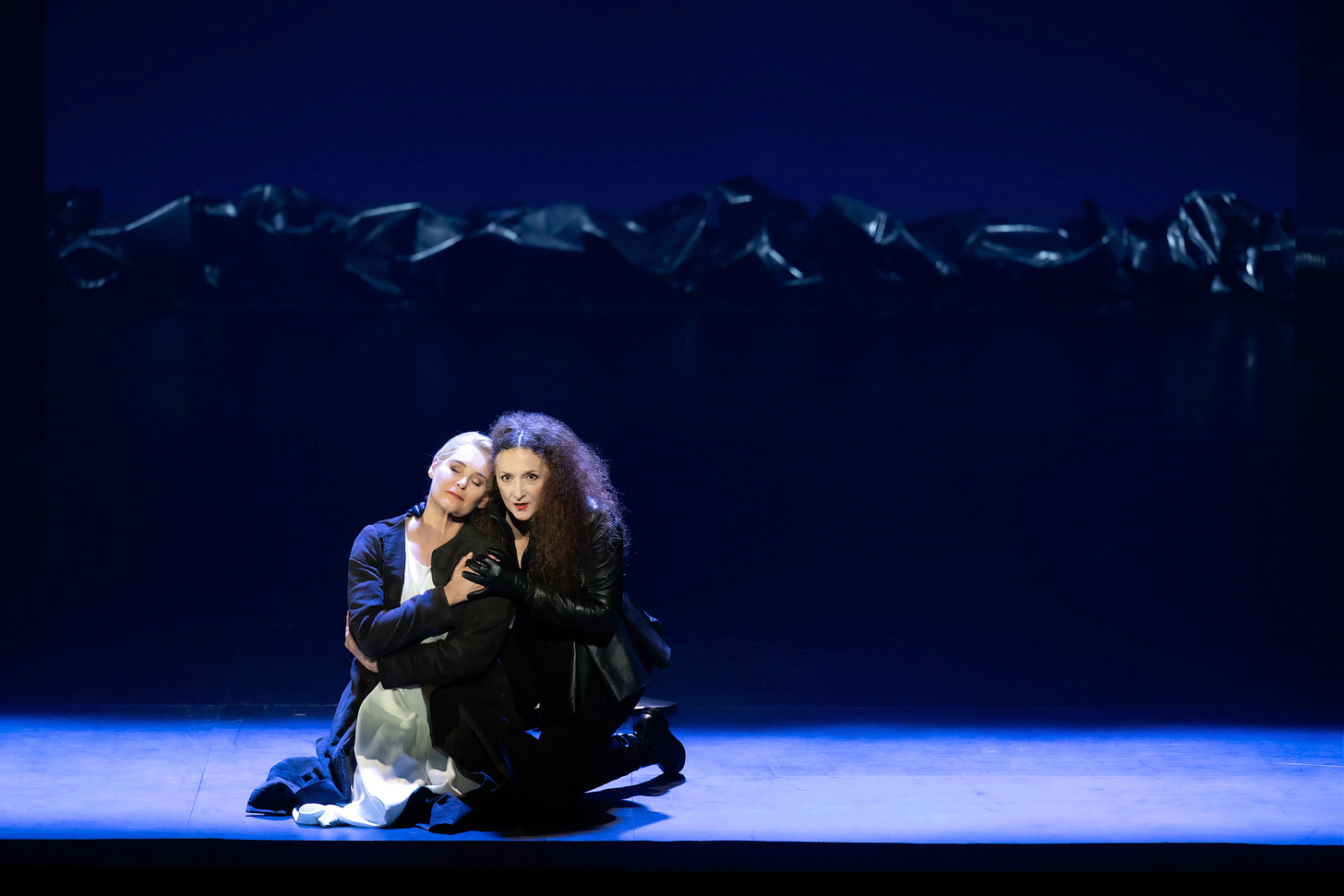Wagnerian conflagration: Ingela Brimberg (Brünnhilde), Ain Anger (Hagen) Picture © Monika Rittershaus
This review appeared first on Oper! Magazin’s website in Jan Geisbusch’s German translation. The original English version appears here by kind permission of the editor, Dr. Ulrich Ruhnke.
When Romeo Castellucci pulled out of La Monnaie/De Munt’s new production of Siegfried planned for October 2024, the Belgian national opera house’s general director, Peter de Caluwe, had a plan B up his sleeve. Castellucci’s Ring was never intended to be seen as a cycle: indeed, I missed his Rheingold a year earlier, but was informed that this was not essential to understanding his concept, as each component of Wagner’s tetralogy had been conceived as an independent entity.
De Caluwe’s solution to Castellucci’s withdrawal was to call on his former boss in Amsterdam, Pierre Audi, who had staged Der Ring des Nibelungen for the Dutch National Opera between 1997 and 2014, during which period cycles were performed three times. De Caluwe - previously Audi’s casting director in Amsterdam - was able to rely on his former colleague to come up with a new concept visualised by different designers: Michel Simon for simpler, lower-tech decors than those contrived by George Tsypin in Amsterdam, and Petra Reinhardt for the elegant, timeless costumes. This Götterdämmerung may not take place in a contemporary ‘here and now’, but Simon and Reinhardt have established an abstract theatrical milieu, perhaps in homage to the late German director Götz Friedrich, whose second Ring production, at Covent Garden in the 1970s was Audi’s first live experience of the complete Ring. At the time, when asked by journalists where and when Wagner’s Ring takes place, Friedrich replied “In the theatre, now”.
Siegfried and the Rhinemaidens: Brian Register, Christel Loetzsch, Jelena Kordić, Tamara Banjašević Picture © Monika Rittershaus
Audi has distanced himself from Castellucci’s four separate entities as far as can be imagined, but his production style has recognisable fingerprints. “I am a narrative director”, he explained in his pre-performance press briefing.
He and Simon (a long-standing collaborator on Audi’s celebrated 1990s Monteverdi trilogy) tell the story of Siegfried in broadly decipherable terms, against Simon’s often striking (if hardly realistic) stage pictures. Use of a double revolves permits two bronzed walls to move into intimations of Brünnhilde’s cave, the Gibichung Hall or the banks of the Rhine, where metallic misshapes suggest rocks, while several float mysteriously above the action. Each act is introduced by projections of children’s drawings of Ring scenes, apparently to suggest a childlike innocence in the relationship of Siegfried and Brünnhilde as their tragedy unfolds: I can’t say this was clear until I read dramaturg Klaus Bertisch’s interview with Audi in the programme book.
The Norns: Katie Lowe, Iris van Wijnen, Marvic Monreal Picture © Monika Rittershaus
After Alain Altinoglu’s brooding, mysterious conducting of the prelude, recalling the Sleep motif of the Earth mother Erda, the curtain rises on her daughters, the Norns (Marvic Monreal, Iris van Wijnen, Katie Lowe), perched in golden quilts on top of one of the mobile walls - an unusually vivid presentation of the prologue in which they predict the world’s end. Later, at the beginning of Act 3, the same platform serves as the place where Siegfried encounters the Rhinemaidens (Tamara Banješević, Jelena Kordiċ, Christel Loetsch), an attractive, euphonious trio first seen cavorting in their swimsuits (with caps and flippers), before changing into strapless ball-gowns for their vain seduction of the ring’s owner. For their final appearance, in the orchestral postlude depicting the flooding of Gibichung Hall and Hagen’s last bid to capture his father’s treasure, they reappear as a trio of avenging furies - grey, dishevelled sisters engulfing the tragedy’s villain.
“Schläfst Du, Hagen, mein Sohn?”: Ain Anger (Hagen) Scott Hendricks (Alberich) Picture © Monika Rittershaus
In the commanding stage persona (and voice) of the Estonian bass Ain Anger, Audi creates one of his most memorable characters. His Hagen is clearly afflicted with a condition that causes him to cradle his head in his hands as he devises his plot to kill Siegfried and gain possession of the ring. Anger’s charismatic presence and black bass voice pin us to our seats both in his summoning of the Gibichung vassals and the conjuration oath with Brünnhilde at the end of Act Two.
It is here that Ingela Brimberg’s Brünnhilde impresses with her bright musical singing and unexpected power. The Swedish soprano is not a genuine hochdramatisch soprano (although two days before this Götterdämmerung premiere, she deputised for Lianna Haroutonian as Isolde in Liège) but she has developed in her early sixties into a big, lyric Wagner soprano, who never sacrifices beauty of line to decibels. Even in the opening “Dawn” duet of the Prologue, Brimberg found a radiance and penetration which was never overwhelmed by Altinoglu’s impulsive, transparent conducting. A the end of the evening her Brünnhilde crowned the performance with a tireless Immolation scene.
Her Siegfried is the US heroic tenor Brian Register - a sturdy singer who lasts the course, even if his tone is not especially alluring (though he sings his recollections of the Woodbird’s Song with musical sensibility). Andrew Foster-Williams’ Gunther portrays a pathologically neurotic character, physically cowed by his half-brother Hagen and jealous of Siegried’s heroic exploits, while Annett Fritsch’s Gutrune makes more than most of the underwritten part of his sibling.
Sister strife: Brimberg (Brünnhilde), Nora Gubisch (Waltraute) Picture © Monika Rittershaus
Nora Gubisch’s Waltraute rises above her unfortunate costuming as a dressed-for-battle Valkyrie, pleading Wotan’s cause and the return of the Ring with desperate urgency. In his short scene with Hagen, Scott Hendricks’ creepy, gruff-voiced Alberich crawls out of one of Simon’s geometrical hidey-holes, his pointy Nosferatu-like fingers preceding him - another memorable image. The theatre’s male chorus dispatches its post-hunt drinking song with tremendous gusto.
De Caluwe has cast Brussels’ Ring not with the usual Wagnerian suspects, but with many artists new to their roles. In the context of his theatre’s medium scale proportions, the imaginative choice of singers underpins the naming of La Monnaie/De Munt as ‘Opera House of the Year’ by the German magazine, Oper!
Cast and Creatives
Performance attended: 4 February 2025
Siegfried Brian Register Brünnhilde Ingela Brimberg Hagen Ain Anger
Gunther Andrew Foster-Williams Gutrune Anett Fritsch Alberich Scott Hendricks
Waltraute Nora Gubisch Norns Marvic Monreal; Iris van Wijnen; Katie Lowe
Woglinde Tamara Banješević Woglinde Jelena Kordić Flosshilde Christel Loetzsch
Orchestra and Chorus (chorus-master Emmanuel Trenque) of La Monnaie/De Munt
Conductor Alain Altinogu Director Pierre Audi Sets Michel Simon
Costumes Petra Reinhardt Lighting Valerio Tiberi
Video Chris Kondek Choreography Pim Veulings Dramaturgie Klaus Bertisch
Further performances: February 15, 19, 23, 26, March 2
Website: lamonnaiedemunt.be








